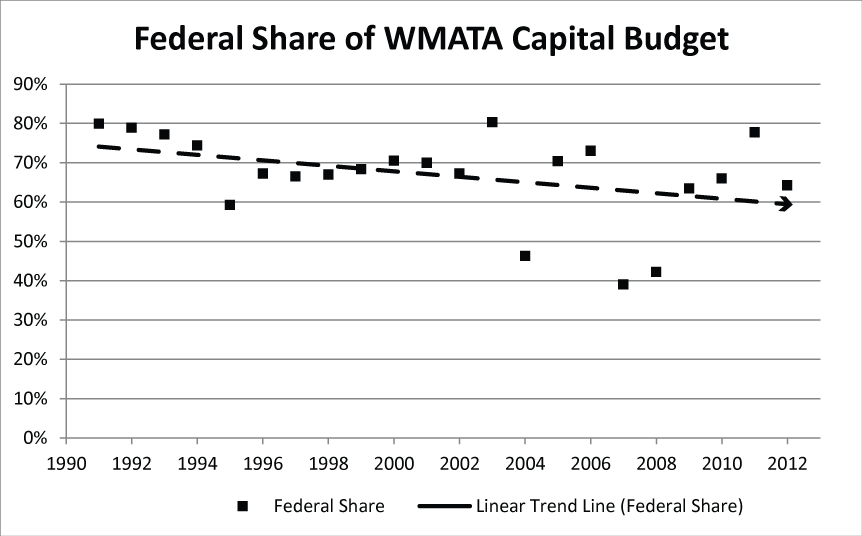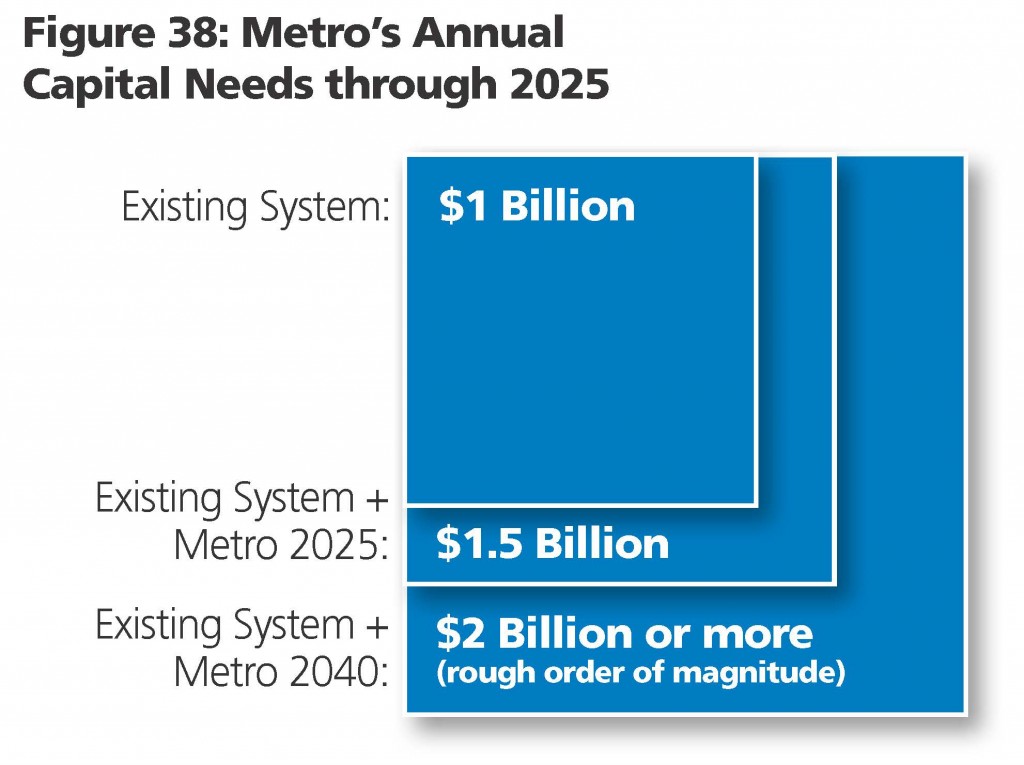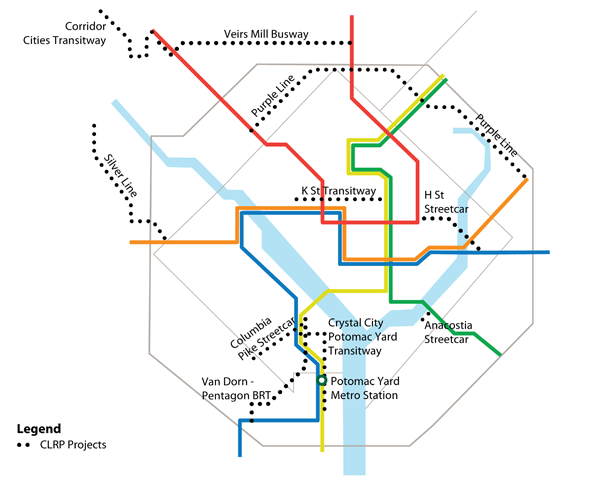Metro’s Momentum plan calls for seven medium-term capital initiatives – known collectively as Metro 2025. And last week, Metro applauded a funding agreement from Maryland, Virginia, and the District of Columbia for $75 million as a “down payment” to begin work on Metro 2025. This is welcome news, indeed, and allows Metro to prepare to begin work on much-needed capacity increases to support the region’s growth.
Those of you who are less familiar with Momentum may be wondering: “What exactly are these projects?”
In a nutshell, the Metro 2025 initiatives are:
 |
Today, most Metrorail trains have only six cars, and that means crowding – which is only projected to worsen. This project would enable Metro to run all eight-car trains in the peak period, which are the longest possible in our stations, and add 35% additional capacity to the rail network. It would expand the rail fleet and yards, and improve the power and signal infrastructure to handle the load. |
 |
If we lengthen the trains, we need to expand key stations as well! Since-eight car trains add capacity for 35,000 more trips per hour, 80% of rail customers transfer or alight in the core, and most of these core stations are already over capacity, we need more core station capacity. This project would enlarge platforms, and add escalators, elevators, stairs, and pedestrian passageways to 15 stations. |
 |
The Priority Corridor Network would construct bus-only lanes, give buses priority at traffic lights, and bring service similar to MetroExtra to 24 lines throughout the region. The PCN will take tens of thousands of cars off the road, add 100,000 riders, moving buses 50% faster, and cut fuel costs.
In addition, this project would expand Metro’s bus fleet by around 400 buses, allowing us to increase frequencies. |
 |
Metro faces a bottleneck at Rosslyn station, where three lines (Orange, Silver, Blue) converge. This major project would try to fix this bottleneck, and restore six-minute Blue Line frequencies between Pentagon and Rosslyn stations. We are analyzing the feasibility of a few options, including a second Rosslyn Station that would enable underground transfers between the two stations. |
 |
This program would expand our current communications infrastructure to provide an integrated one-stop communication hub for the regions’ transit customers. Improvements would include: radio system upgrades, real-time bus information at bus stops, and new public address system at stations. |
 |
This project would add special trackwork at key locations in the rail network to give us more flexibility with Metro’s two-track system. These new tracks would allow us to turn trains around, add system flexibility to Metro’s two-track system, and store trains at important locations. |
They don’t give out Academy Awards for transit advocacy short films, but maybe they should…
Today, one of our Momentum Champions, the Coalition for Smarter Growth, launched their own grassroots campaign to build support for funding Momentum. They are sending an initial email blast to 20,000 of their supporters.
The video, embedded below, that they produced accompanies a new tool that allows individuals to send emails of support directly back to their specific elected officials. Click the button at the bottom to show your support.
What is Metro Momentum? from
Coalition for Smarter Growth on
Vimeo.

We would like to extend our heartfelt thanks to the Coalition and we applaud them for taking a stand on this critical regional transportation issue. We hope that you have a chance to view their handiwork and are so inclined to indicate your support for Momentum and Metro 2025 funding.
February 24th, 2014
Shyam
Counting on the Feds alone to fund Metro ignores a long tradition of local jurisdiction funding support – and a ticking clock.

Image borrowed from eRationalmarketing.com. Click for original.
As the region grapples with mounting infrastructure needs (DC, MD and VA) regional leaders are experiencing a bit of sticker shock. That’s because this region has been enjoying the benefits of massive infrastructure capacity increases in transportation, water/sewer, and power that were built in the 1970s and were designed to keep up with growth for half a century.
Those fifty years have almost run out, as has our ability to grow into the capacity built by the previous generation of leaders. And if this region is going to continue its growth trajectory into the middle of this century, we’re going to need to invest in the supporting infrastructure capacities – including funding transit capacity increases via Metro 2025.
Some have argued that funding Metro improvements is primarily responsibility of the Federal government, or at least that the Federal government should lead this effort. That line of argument syncs up neither with the past, present or future – in reality, local jurisdictions have always played a significant role in funding Metro. Let’s lay out the facts about role of local jurisdictions in funding Metro.
- Fact: From 1969 to 1999, of the approximately $10.0 billion spent to construct the original 103-mile system, about $3.8 billion came from local jurisdictions, who always played a large role in the infrastructure investment:
- Fact: System enhancements, such as the Largo Extension and NoMA station, were largely paid for with local money. The Largo extension was paid for with 40% local money (DOC), and the NoMA station was funded with a combination of public and private local monies (PDF) that comprised more than 75% of the capital cost.
- Fact: As WMATA’s Capital Improvement Program (CIP) transitioned from a system expansion focus to more infrastructure renewal, the reliance on federal funding declined. Just look at the graphic below.

Federal share of WMATA capital budget, 1991 to 2012. Source, NTD.
- Fact: While the 2008 Passenger Rail and Infrastructure Investment Act (PRIIA) authorizes $1.5 billion over ten years to support WMATA’s CIP, Congress was clear in mandating that this funding is contingent upon matching contributions from the region’s governments. In other words, without local jurisdiction funding commitments, monies from the Federal government would not materialize.
- Fact: Among the
two three that does not have a dedicated regional funding source. This despite being the second busiest subway and sixth busiest bus operator in the entire nation.
Those that monitor the Federal government know well that funding sources for major capital projects are in decline, and there are no guarantees to the legislative process. Just take a look at this graphic, from the U.S. Department of Transportation’s Highway Trust Fund Ticker. Read more…
Like many of the nation’s transit  agencies, Metro must rebuild its once-new capital assets as they wear down and deteriorate after decades of use. Metro could feasibly use every penny in its capital budget for years to come just reducing its backlog of maintenance issues. Moreover, Metro also needs to ensure that the system is able to overcome the capacity constraints that come with a regional population expected to swell in both the central core and the suburbs in the years ahead. And on top of this, Metro will need to address calls for entirely new service in many areas of the region. Once Metro is rehabilitated, the system will require a stable level of investment to maintain a state of good repair as it continues to age and deteriorate. Metro estimates that $1 billion (in 2012 dollars) per year is necessary to support and maintain the existing system, even after rehabilitation. Metro 2025 will expand the core and system capacity, as well as ensure that the region’s capital investments are successful. This requires an additional $500 million, on average, in annual capital funding through 2025.
agencies, Metro must rebuild its once-new capital assets as they wear down and deteriorate after decades of use. Metro could feasibly use every penny in its capital budget for years to come just reducing its backlog of maintenance issues. Moreover, Metro also needs to ensure that the system is able to overcome the capacity constraints that come with a regional population expected to swell in both the central core and the suburbs in the years ahead. And on top of this, Metro will need to address calls for entirely new service in many areas of the region. Once Metro is rehabilitated, the system will require a stable level of investment to maintain a state of good repair as it continues to age and deteriorate. Metro estimates that $1 billion (in 2012 dollars) per year is necessary to support and maintain the existing system, even after rehabilitation. Metro 2025 will expand the core and system capacity, as well as ensure that the region’s capital investments are successful. This requires an additional $500 million, on average, in annual capital funding through 2025.
Certainly, increases in the overall size and scope of the system will also have an impact on operating costs, which would grow to some degree when new rail cars, buses, and service are put in place. These operating costs may grow in line with the proportional size of system expansion or at a lower rate, especially if increases in reliability and the increased attractiveness of transit to today’s non-riders has a disproportionate effect on ridership, mode choice, and revenues for modes that have high farebox recovery ratios today and/or where existing demand is already delivering more revenue than operating costs.
Read more…
The National Capital Region Transportation Planning Board (TPB), the region’s Metropolitan Planning Organization (MPO), adopts the region’s constrained long-range plan (CLRP) annually. Only projects included in this regional transportation plan are eligible for federal funding, and since 1991, federal law requires the CLRP to be constrained financially. This regional transportation plan includes only projects that are reasonably expected to be fully funded.
Read more…







Recent Comments